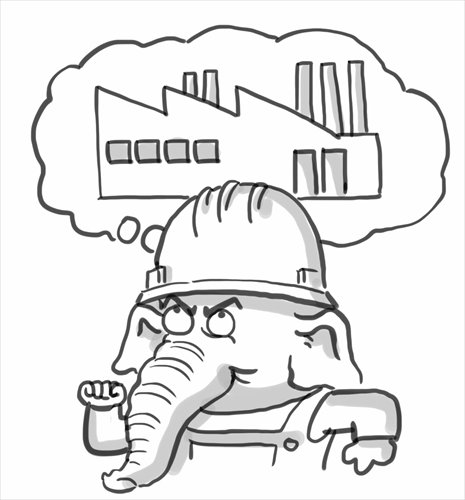Beijing offers manufacturing lesson to Delhi

Illustration: Liu Rui/GT
The "Make in India" campaign, launched by Indian Prime Minister Narendra Modi with the purpose of turning India into a new global manufacturing center, now has come into full swing.
Modi chose to initiate the campaign in late September ahead of his US trip, in order to show that India would have a bright future under his leadership and to display New Delhi's potential and determination to challenge China, the current international manufacturing hub.
India has long suffered from a backward manufacturing industry, the output value of which only accounts for approximately 15 percent of India's GDP. And given the poor quality of its products, the country has had to import everything from furniture and vehicles, to industrial machinery.
A large number of Indians are out of work. Every year more than 12 million young people enter the labor market, but most of them fail to find a full-time job. In the past decade, the software industry has only created around 2 million jobs despite its fast development.
The sluggish manufacturing industry and the substantial number of unemployed young people constitute two chronic social maladies hampering India's economic and social development.
Modi has been devoted to promoting India's reform since assuming office. Infrastructure development, manufacturing and the building of smart cities have become the three supporting pillars of his economic reform strategy. Meanwhile, he has been sparing no effort to punish corruption and improve administrative efficiency to create a favorable environment for foreign investors.
Recently, the Indian government decided to invest 500 billion rupees ($8.1 billion) to build six submarines instead of outsourcing such advanced weaponry as they did in the past. This decision tallies well with Modi's ambition of ramping up India's manufacturing industry. In this way India will make remarkable progress in manufacturing, but it is still uncertain whether it will become the next global manufacturing center.
In the past, New Delhi failed to see rapid growth in its manufacturing industry because of outdated infrastructure, difficulties of acquiring land and rigid labor laws, which the Modi government is trying to overcome.
But now, the key concern is that India is a federal state without consistent and transparent land use approval policies in different states.
For Modi, it is easy to turn Gujarat into something similar to South China's Guangdong Province, but hard to turn India into the world's manufacturing center, as the democratic system has hindered its development to a certain degree.
The so-called demographic dividend constitutes another advantage for Modi. It is true that there is a larger young population and cheaper labor costs in India than in China, which, however, will not necessarily convert into demographic dividend.
To create more jobs for its unemployed young people, India must first of all develop labor-intensive industries, which is not what the Indian government wants to do. Instead, Indian officials want to give priority to industries at the high end of the value chain.
New Delhi attempts to obtain foreign funds and technology by playing up to several major powers. Such opportunism may be unduly idealistic. India wants China's capital and also the technology of the US and Japan so it can surpass China, but it may end up with nothing. Furthermore, economic nationalism has long been reigning over India and therefore the Modi government will hardly allow foreign firms to acquire the biggest benefits from its economic development.
In actuality, with the US stepping out of quantitative easing and global credit costs rising, India has to cooperate with China to become a significant part in Asia's production chain if it desires to become a manufacturing power.
A China-centered Asian production chain that is synchronous with the region's financial framework has taken shape. This chain can be extended, but it is difficult to replace it with a new one. If New Delhi is reluctant to be part of this chain, it is not likely to become a manufacturing power.
Regarding India's ambition, what Beijing needs to do is make concerted efforts to upgrade its products and the quality of "made in China" commodities to march toward the high end of the value chain.
The author is a research fellow of Shanghai Institutes for International Studies and a visiting fellow of the Chongyang Institute for Financial Studies, Renmin University of China. opinion@globaltimes.com.cn